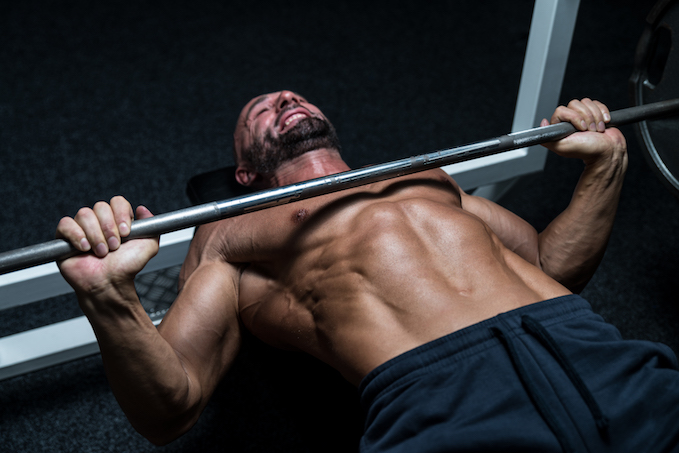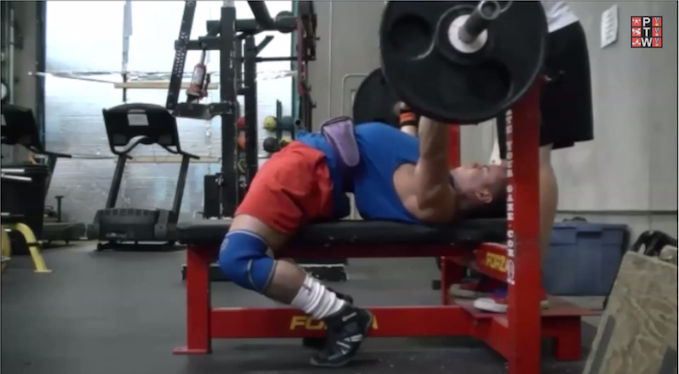Should You Bench Press With Your Feet Up?

The bench press is a core gym exercise, and for many people is a mark of how strong they are.
And even if you don’t work out your bench press regularly, chances are that you’re at least pretty familiar with the exercise.
But for an exercise that is so common, and that most of us have done at one point or another, it is surprising that there isn’t a clear consensus on how to do it properly.
Yup, if you take a look at people benching at your gym, you’ll likely notice a bunch of different styles…
Some will have their legs planted firmly on the ground; others will have their feet up on the bench, or even in the air.
Is one of these the correct style?
Well, if you ask a lot of trainers at gyms these days, they’ll tell you that benching with your legs up is the right way to bench.
However, this simply isn’t true – so don’t get suckered into doing this just because some trainer says so.
Let me go through why most people shouldn’t bench press with their feet up on the bench, and what you should be doing instead.
How It All Started
To help understand why so many well-meaning trainers are recommending this, we need to take a quick look at how powerlifters typically bench press.
You see, powerlifting is a sport that revolves around maximizing the amount of weight you can lift in 3 specific exercises – the squat, and bench press, and the deadlift.
For this reason, powerlifters do whatever they can to make each of these exercises as mechanically efficient as possible.
When bench pressing, this means arching their back and driving their feet through the floor, which shortens the distance the bar must travel for a successful rep and also allows more weight to be lifted due to the leg drive.
And in their quest to really shorten the range of motion as much as possible, you have some examples of ridiculously arched backs.
Like this one, for instance:

Obviously this doesn’t look like a regular bench press at all!
Many trainers argue that it doesn’t work the chest as effectively, given the tiny range of motion, and that it can be dangerous for your back to arch this much.
The Feet Up Solution
Putting your legs up on the bench takes care of both of these potential problems.
It flattens your back and it takes any sort of leg drive out of the equation.
As a result, it has been argued that benching with your legs on the bench – or in the air – is safer AND more effective at isolating your chest.
You have a greater range of motion, and your chest has to do all of the work, without any help from your legs.
Moreover, advocates of this method claim that it works your core at the same time, since you have to use more core strength to maintain stability without your feet on the floor.
But despite all of these claims, this method isn’t without its share of drawbacks…
The Downsides Of Bench Pressing With Your Feet Up
As I discussed in my common bench press mistakes article, one of the biggest potential dangers when bench pressing is having your elbows flare out to the sides.
This places a lot of strain on your shoulders, and can lead to painful rotator cuff injuries.
The simple fix for this is to keep your scapula retracted, so that you are effectively lying on the backs of your shoulders.
This keeps your elbows closer to your body, and takes a lot of strain off of your shoulders.
Well, it is very difficult to properly retract your scapula (tuck your shoulders), when your back is flat on the bench with your legs up.
This arguably makes this style of bench pressing more dangerous than benching with a moderate arch (which doesn’t actually place much strain on your lumber spine at all).
But that’s not all…
You see, when you take your feet out of the equation, you definitely reduce a lot of stability – but this isn’t necessarily a good thing.
You don’t want to be lifting heavy weights when you’re shaking around and trying desperately to stabilize yourself with your core.
This isn’t safe at all. You aren’t concentrated on the particulars of form, but rather on not wobbling around on the bench!
And of course, this also means that you won’t be comfortable lifting nearly as much weight as you would if your feet were firmly planted on the floor with a slight arch in your back.
This ultimately leads to less muscular development, since you won’t be inducing progressive overload nearly as effectively with sub-maximal weights.
Yup, it turns out that a lot of the supposed benefits of benching with your feet up aren’t all they’re cracked up to be.
So Should Anyone Bench With Their Feet Up?
The short answer to this is yes, but only in very specific situations.
Basically, the only time you should be benching with your feet on the bench is if you experience pain when arching your lower back.
That’s it.
In all other situations, you should keep your feet firmly planted on the floor, with your scapula pulled back, while maintaining a moderate arch in your lower back.
This is simply the safest and most effective way to bench press for most people.
Try it and see the difference for yourself.